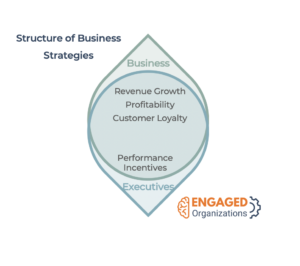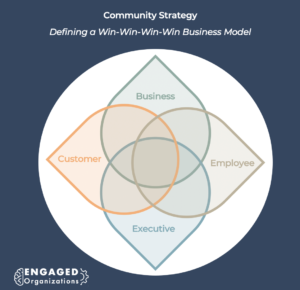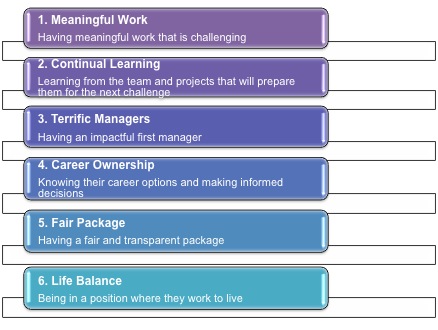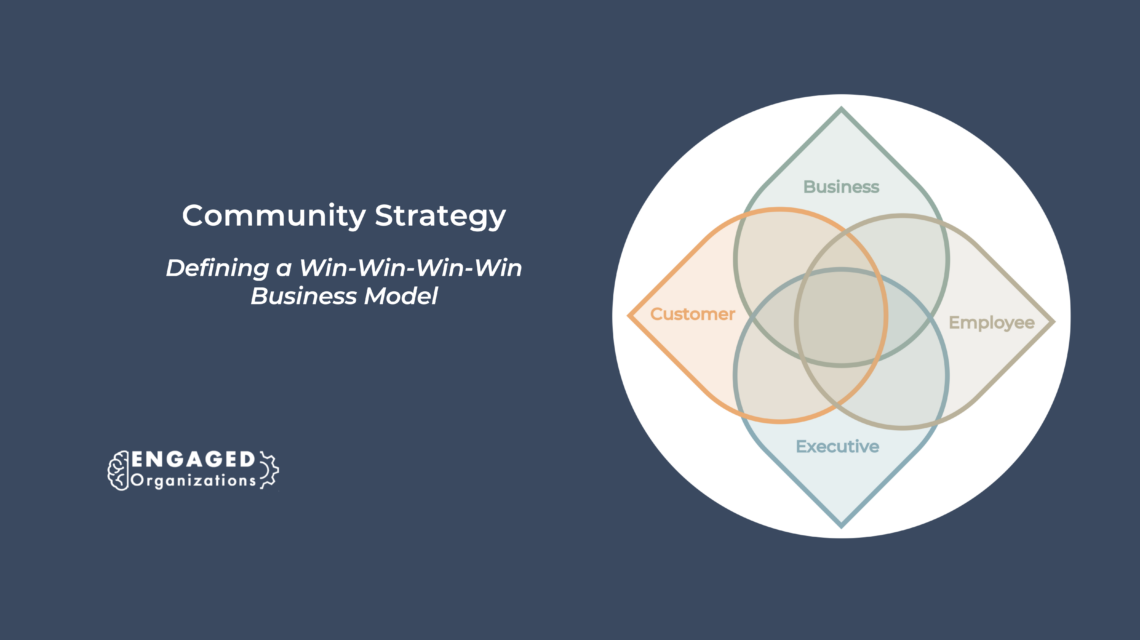
Organizations that create compelling collaborative strategies benefit from dramatically lower friction – and lower operational costs. Yet creating these collaborative, engaged, and psychologically safe workplace seems to bedevil most organizations. I believe it is the way we think about and construct business models and strategies. Too often, the non-financial values go unconsidered in business models because they can’t easily be quantified financially. Leaders may acknowledge intrinsic values but it doesn’t make it to the balance sheet or the business modeling exercises.
After all, employees are liabilities on financial balance sheets and are not recognized as accruing assets. That reality too often translates into organizational cultures that make employees feel disposable. The Great Reevaluation should come as no surprise. The business model always wins; most only include the organization’s financial performance and the financial rewards for executives who operate it.
Business Models Influence Cultures
If an organization does not understand the impact of trust, psychological safety, and engagement on its ability to thrive, one needs only to review its business model and metrics to see that. They will reveal what matters.
Financial documents articulate an organization’s values and priorities. They are tools to ensure those values are realized.
Angela Blanchard
If we throw up our hands and dismiss the possibility of understanding the investments required and the potential rewards of trust and see employees primarily as liabilities, employees are unlikely to ever feel valued and secure. If we don’t make employee success the same as organizational success, we will continue to go through cycles of layoffs and employee surveillance that will continue to reinforce employee anxiety and cynicism, which will slowly and then quite quickly eat away at the organization’s value and increase its cost of operations.
Today’s predominant business models maximize near-term revenue growth and profit, much of which is irrelevant to the desires, aspirations, and objectives of employees – or even of the long-term stability of the organization. Even executives’ incentives are mercenary, focused primarily on financial milestones and progress. The focus on financial rewards is particularly attractive to a certain type of executive; those who place a priority on money over relationships and people. We wonder why we cannot get away from executives who think transactionally but we continue to reward mercenary thinking and mindsets. Those leaders who care about people, elevate others instead of themselves, and act as mentors are not rewarded for those priorities – and few survive an executive culture consumed with money and interpersonal competition.
Cultures created by revenue growth and maximization business strategy are transactional, competitive, and secretive – all the things that prevent safety and trust and with it, learning and innovation.
Community Strategies Create Convergence
Revenue growth, profitability, and sustainability are increasingly in conflict as technology, information transparency, and globalization increase. Fast revenue growth required quick and immediate customer adoption, by any means necessary. Sustainable financial margins and financial stability require trust, relationships, and innovation – all things that take investment and time. Organizations have historically tried to maintain a balance but that balance is becoming riskier – and preventing organizations from doing either well. This confusion is exemplified by private equity firms, who ostensibly buy companies to ‘fix’ a revenue growth or profitability problem and instead end up hollowing out their value to make a quick buck – often killing the company in the process. Because of bankruptcy regulations, these firms can transfer much of the debt liability to others, including the public. While arbitraging money by taking advantage of bankruptcy laws to shed debt is lucrative, it hurts an organization’s employees, communities, customers, and partners. It rewards shuffling financial debt around over conservative, sustainable growth and development.
Community business models are not only better for ecosystems, our democracy will collapse without them because financial value, on its own, is hollow. Arbitraging financial value benefits only a small handful of individuals who are least likely to need it because it requires huge amounts of capital to accomplish. When a strategy is built to give every stakeholder more value back than they contribute it generates pull that naturally leads to alignment and lower operational costs.
Humanistic business models are not new and, in fact, they often look more like the business models of the past. Ironically, some of the largest organizations that use these models are organizations that have been very slow to ‘modernize’ over the last 40 years. Community business models also tend to be used by private companies that have more influence over their own strategies and can be more ‘mission-driven,’ caring for their communities and employees. One of these companies – with an excellent case study available – is Brunello Cnucinelli S.p.A. Brunello Cnucinelli is a European luxury goods brand with an intense commitment to craftsmanship; in other words, they never ‘modernized’ their business model. There is an explicit acknowledgment that employees are fundamental to the success of the business. It is baked into everything they do. Not surprisingly, revenue growth is not a goal for the sake of growth; sustainability of revenue is.
These community business models include many stakeholders explicitly in the business model and strategy. They put a priority on shared purpose and co-created value so that each stakeholder can be proud of and invested in the success of the organization. It is an interdependent ecosystem that reinforces trust and credibility. It’s the type of organization that every stakeholder – including customers – is happy to support. That systemic trust creates a calm, predictable, deliberative culture; one that is sustainable for not just the business but for employees. It is everything most companies are not but I think the type of organization that is more likely to thrive – and ironically grow – in an environment of noise and cynicism.
Trust is the differentiator in a chaotic environment; increasing customer loyalty, organic advocacy, employee loyalty, and operational efficiency.
Rachel Happe
How to Build a Win-Win-Win-Win Strategy

Developing a community strategy requires a deep understanding of core constituents. The number of core constituent groups changes by organization but, for the sake of simplicity, let’s look at four: the company, executives, employees, and customers. The first task is to understand what each of these groups wants, needs, and aspires to; what will make each stakeholder content and committed to active engagement? The overlap in the objectives of the organization, executives, employees, and customers is where the optimal mix of stability, sustainable revenues, and profit margin lies.
One of the issues with identifying the objectives of employees and customers is how organizations tend to think about them, which is by thinking of employee and customer ‘experience’ (the experience they have with the organization). This perspective betrays itself as self-absorbed and centered around the organization. Because the experiences of its customers and employees are viewed from the wrong context, true understanding is filtered through organizational priorities, warping it in a way that can hide make it misunderstood and transactional. Understanding the objectives of each group is better done via an anthropological or design thinking process and then combined with research about psychology, sociology, history, and anthropology. Employee and customer objectives need to be viewed from the perspective of how the organization fits into their lives.
One company that has defined employee objectives well is P&G. They call their employee model the Employee Value Equation and it is a combination of six elements valued by individuals when considering their employment:

1. Meaningful Work
2. Continual Learning
3. Terrific Managers
4. Career Ownership
5. Fair Package
6. Live Balance
What P&G recognizes is that many things other than financial benefits matter to people and these objectives require investment and need to be designed into the business. P&G does something else too; its intent is to hire people for their career and then provide them with the opportunities to grow, whether that is in a new role, moving to a new location, or working in a different business unit or function. It is no surprise that P&G’s CEO, David Taylor, started as a plant production manager.

Together, the shared objectives of the organization, its executives, its employees, and its customers sit at the heart of a community-centric, win-win-win-win strategy that informs the business model. By connecting the objectives of different constituents, a more resilient and sustainable operational approach can be defined. In this example, profitability is increased by customer trust which increases with the reliability of the product or service. Product reliability aligns with executive interest in ensuring predictability, which is realized when employees feel supported and can execute effectively and feel encouraged to identify and respond to issues as they arise.
To see these win-win-win-win values, metrics need to adapt. While culture is impossible to value on its own, its realized value (its impact on workflows and outputs) CAN be measured. The workflow for one stakeholder group then needs to be connected to its impact on the workflow and experience of other stakeholders. For example, the supportive work culture might actually slow down work because more issues get identified and fixed, which increases quality because of the increase in care during production. If the production cycle time was measured in isolation, it would be easy to draw the wrong conclusion. The interdependency is critical to align and measure so that improved customer satisfaction and repurchase can be connected back to changes to the production process. One of the biggest faults of measurement is in isolated metrics and assuming they are not interdependent, all because we are consumed with the idea of measuring employee productivity. Measuring each piece of a system in isolation optimizess the subsystem to the detriment of the entire system; perhaps the biggest reason to include all of the major stakeholders in the business model explicitly. What value does a slower, more deliberate production cycle have on cost and revenue AND customer satisfaction and employee engagement? The balance between those metrics – not optimization of one – is the best outcome for the ecosystem. That balance ensures everyone in a community wins – and received more value than they contributed, ensuring they are engaged and committed.
What Business Are You In?
While there are plenty of business models that will allow for high growth, they sacrifice either customers’ (ahem Facebook) or employees’ (Apple, Nike…) interests. Sustainable business models are less sexy; they tend to grow slowly and incrementally while deepening trust, which grows slowly at first and then accelerates as the community expands. These are the organizations most of us would love to work for because they are healthy cultures where we can learn and do work that makes us proud.
In your organization, how are employees’ interests reflected in the business model? Are they an unnecessary cost of doing business or are they considered vital to quality and innovation? Worse still, does your organization claim to prioritize innovation while treating employees like commodities?
I want a world where we all have dignity and respect from the organizations with which we do business. Call me newly old-fashioned.


